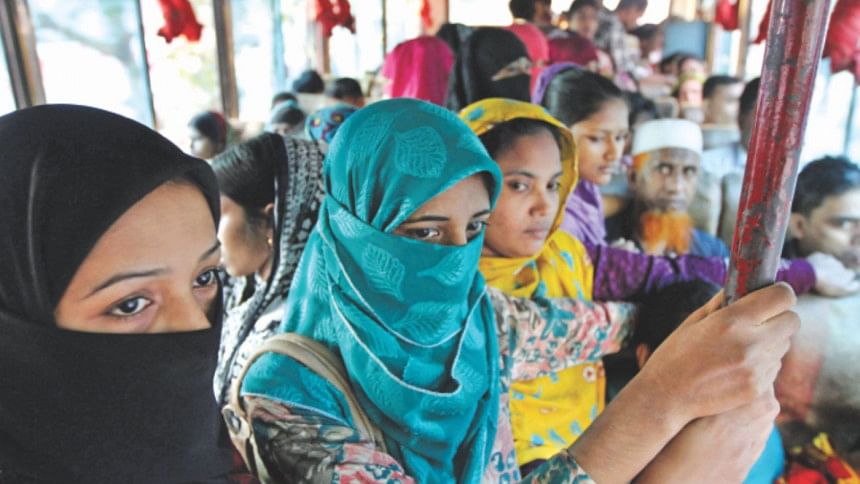The widening scourge of sexual harassment

Violence against and violation of women result from "some of the worst forms of discrimination" that continue unabated in a variety of ways: mistreatment, harassment, lewd stares, groping, maiming, raping, and even murdering. With choices that matter to women in their hands, men seem to have been endowed with an arcane sense of entitlement to do as they wish with the lives of women.
The result, more often, is vulgar, depraved and dehumanised behaviour, occurring widely, with regularity, and without any sign of abatement. The perpetrators appear to be convinced that they will bear no consequence for their unrelenting and atrocious acts. The phenomenon is apparently a global one that has become an everyday bitter experience for uncounted females stepping out into an unsafe world to make a living.
There is unfortunately no comprehensive study on this issue in Bangladesh. Based on a two-phased study—a qualitative phase and a quantitative survey phase—this article touches upon three findings: the nature of sexual harassment, who commits them, and how widespread the phenomenon is.
Nature of sexual harassment
It was determined that 94 percent of the women using public transportation have experienced sexual harassment at some time; such harassment occurs more on public transportation than on the streets.
Verbal harassment is very common and takes the following forms: (i) Calling out or passing a comment such as "sexy", "baby", etc; (ii) Whistling or making kissing sounds; (iii) Asking personal questions or soliciting cell phone numbers and/or Facebook/Twitter ID; (iv) Using obscene/abusive language; (v) Sexual teasing, joking or making remarks; (vi) Commenting on clothing, anatomy or looks; and (vii) Asking to be a girlfriend, about sexual life, or soliciting sexual favours.
Physical harassment includes the following: (i) Deliberate touching/pinching; (ii) Making contact by leaning closely or pushing gently; (iii) Playing with women's hair; (iv) Putting hands on women's shoulders; (v) Standing too close or brushing up against a woman; (vi) Touching/rubbing/pressing private parts; (vii) Patting on the buttocks; and (viii) Poking with private parts.
Other forms of harassment include: (i) Staring lewdly or ogling; (ii) Showing indecent pictures on their cell phones; (iii) Making obscene gestures; (iv) Following/stalking secretly; (v) Showing genitals; and (vi) Taking a picture/video by a cell phone.
Who commits these acts of indecency?
In the case of public transportation, 35 percent female commuters indicated facing sexual harassment by male commuters aged 19-25 years. Almost 59 percent of the respondents indicated that men aged 26-40 years had harassed them. To some surprise and consternation, the worst age group of male commuters who harass female commuters is between 41-60 years. Around 66 percent of the women respondents accused this age group for sexually harassing them.
A male student from a private university said, "Somehow my perception is that aged people are more prone [to harassing], not the young people that much." Another male student disclosed, "One of my close female friends had been harassed badly. A person over 50 brushed against her private parts." The shocking fact is sometimes they are of the age of the target group's fathers or even grandfathers. A garment worker said, "Old people close to my father's age are the worst. When they do something inappropriate, I call them 'Abba' (father) to make them feel insulted."
How widespread is harassment?
People who sexually harass women come from various tiers of society, age groups, and geographical areas (urban, peri-urban, and rural), unveiling the pervasiveness and epidemic nature of this problem. Surprisingly, many of them are well-educated and hold decent jobs. According to a female university student, "Those who are spoiled or come from a lower class harass without any hesitation; the educated people also do the same thing but subtly and within a limit as they fear for their social reputation."
In our search for patterns, interestingly, we found none. The study involved young and older women, from different occupations (students, working, or homemakers), and from three locations (urban, peri-urban, and village). They all suffered comparable and high levels of sexual harassment—to the extent that this scourge may be deemed a public safety hazard.
What has gone wrong?
It has probably been this way for long. Men's temerity may in fact be on the rise, unshackled by lax laws and poor law enforcement, their growing feelings of entitlement, a rising tide of corruption with absolute nonchalance, and the egregious inattention to designing public transportation systems that are inclusive and respectful of women.
The spotlight may also be trained on whether with rising economic growth and a focus on attaining middle-income status, we have lost our moral moorings. Economic growth is unlikely to be sustainable if the country's social and moral edifice is feeble, social justice is cast to the winds, and women as partners are disrespected, as displayed crassly in our streets and public transportation system.
Women are not only going to be present in the public domain; they will be there in greater numbers as they educate themselves and seek opportunities whereby they can flourish and thrive. On International Women's Day—and every other day—there must be a firm resolve to recognise and celebrate our friends, partners and caregivers (yes, our mothers, spouses, daughters, sisters, and co-workers). The onus is particularly on men to self-reflect and deliver.
There is much to be done on three fronts: capacity building, social mobilisation by harnessing the power of the media, and strengthening policy along with appropriate interventions to bring desperately needed changes. It goes without saying that we must also monitor, through continuous audits, the progression of women and their changing experiences. It is also vital to reinforce the notion that women's place in society reflects what they earn with their hard work and ingenuity, not what men deem fit to accord to them.
Syed Saad Andaleeb is Vice Chancellor, BRAC University, Bangladesh. The original study was initiated and supported by the BRAC Road Safety Program with support from BRAC Gender Justice and Diversity Program.





Comments